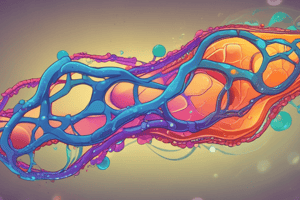Podcast
Questions and Answers
What is the main function of ATP synthase in cellular metabolism?
What is the main function of ATP synthase in cellular metabolism?
- Utilizing the proton gradient to synthesize ATP (correct)
- Producing electrons through the ETC
- Oxidizing NADH and FADH2
- Creating a proton gradient across the mitochondrial matrix
Which part of the cell is responsible for electron transport and oxidative phosphorylation?
Which part of the cell is responsible for electron transport and oxidative phosphorylation?
- Endoplasmic Reticulum
- Nucleus
- Cytoplasm
- Mitochondria (correct)
Which organelle is responsible for generating the majority of cellular ATP through oxidative phosphorylation?
Which organelle is responsible for generating the majority of cellular ATP through oxidative phosphorylation?
- Lysosomes
- Mitochondria (correct)
- Endoplasmic reticulum
- Golgi apparatus
What is the primary energy currency of the cell that is generated by electron transport and oxidative phosphorylation?
What is the primary energy currency of the cell that is generated by electron transport and oxidative phosphorylation?
What is the primary energy currency of the cell that is involved in various cellular processes?
What is the primary energy currency of the cell that is involved in various cellular processes?
Which enzyme is responsible for converting ADP and inorganic phosphate into ATP during oxidative phosphorylation?
Which enzyme is responsible for converting ADP and inorganic phosphate into ATP during oxidative phosphorylation?
How does the movement of electrons through the electron transport chain contribute to ATP synthesis?
How does the movement of electrons through the electron transport chain contribute to ATP synthesis?
In the electron transport chain, where are the protein complexes located?
In the electron transport chain, where are the protein complexes located?
Which complex in the electron transport chain is responsible for transferring electrons from NADH to ubiquinone?
Which complex in the electron transport chain is responsible for transferring electrons from NADH to ubiquinone?
Which process involves the transfer of electrons through a series of protein complexes to establish a proton gradient?
Which process involves the transfer of electrons through a series of protein complexes to establish a proton gradient?
What type of reactions occur in the electron transport chain to release energy?
What type of reactions occur in the electron transport chain to release energy?
What is the role of mitochondria in addition to ATP synthesis in cellular metabolism?
What is the role of mitochondria in addition to ATP synthesis in cellular metabolism?
Flashcards are hidden until you start studying
Study Notes
Electron Transport and Oxidative Phosphorylation: The Powerhouse of Cellular Metabolism
Introduction
Electron transport and oxidative phosphorylation are integral parts of cellular metabolism, occurring in the mitochondria of both eukaryotic and prokaryotic cells. These processes are crucial for generating ATP (adenosine triphosphate), the primary energy currency of the cell, which powers various cellular functions.
Electron Transport Chain
The electron transport chain (ETC) is a series of protein complexes embedded in the inner mitochondrial membrane that facilitate the transfer of electrons from electron donors to electron acceptors. This process involves a series of redox reactions, where electrons are transferred from molecules with higher energy levels to those with lower energy levels, releasing energy in the process. The ETC is composed of four main complexes: Complex I (NADH:ubiquinone oxidoreductase), Complex II (succinate:ubiquinone oxidoreductase), Complex III (cytochrome bc1 complex), and Complex IV (cytochrome c oxidase).
Oxidative Phosphorylation
Oxidative phosphorylation is the process by which the energy released from the ETC is used to create a proton gradient across the inner mitochondrial membrane. This gradient is then utilized by the enzyme ATP synthase, also known as Complex V, to convert ADP (adenosine diphosphate) and inorganic phosphate (Pi) into ATP. The proton gradient is established by the sequential transfer of electrons from electron donors (such as NADH and FADH2) to electron acceptors (such as oxygen) through the ETC. The movement of electrons through the ETC is coupled with the translocation of protons from the mitochondrial matrix to the intermembrane space, creating a proton gradient.
ATP Synthesis
ATP synthase uses the energy from the proton gradient to synthesize ATP. The enzyme contains two main subunits, F0 and F1, which act as a rotational motor system. F0 is embedded in the inner mitochondrial membrane and contains a proton corridor that is protonated and deprotonated repeatedly as protons flow down the gradient. This ionization causes rotation, which alters the orientation of the F1 subunits. F1 is hydrophilic and faces the mitochondrial matrix, where conformational changes in the F1 subunits catalyze the formation of ATP from ADP and Pi.
Mitochondria
Mitochondria are often referred to as the "powerhouse" of the cell due to their central role in ATP production. They are organelles found in most eukaryotic cells and are responsible for generating the majority of cellular ATP through oxidative phosphorylation. In addition to their role in ATP synthesis, mitochondria also play a key role in other cellular processes, such as cellular respiration, fatty acid oxidation, and calcium homeostasis.
Energy Production
The energy produced by oxidative phosphorylation is used to carry out a wide range of cellular processes. ATP is the primary energy currency of the cell and is involved in various processes, including muscle contraction, protein synthesis, and active transport of molecules across cellular membranes. The energy released during oxidative phosphorylation is also used to maintain cellular homeostasis, such as maintaining the cell's internal pH and regulating ion concentrations.
In conclusion, electron transport and oxidative phosphorylation are essential processes for cellular metabolism, responsible for generating ATP and maintaining cellular energy homeostasis. These processes occur in the mitochondria and involve the transfer of electrons through a series of protein complexes, which establish a proton gradient that is then used to synthesize ATP.
Studying That Suits You
Use AI to generate personalized quizzes and flashcards to suit your learning preferences.




